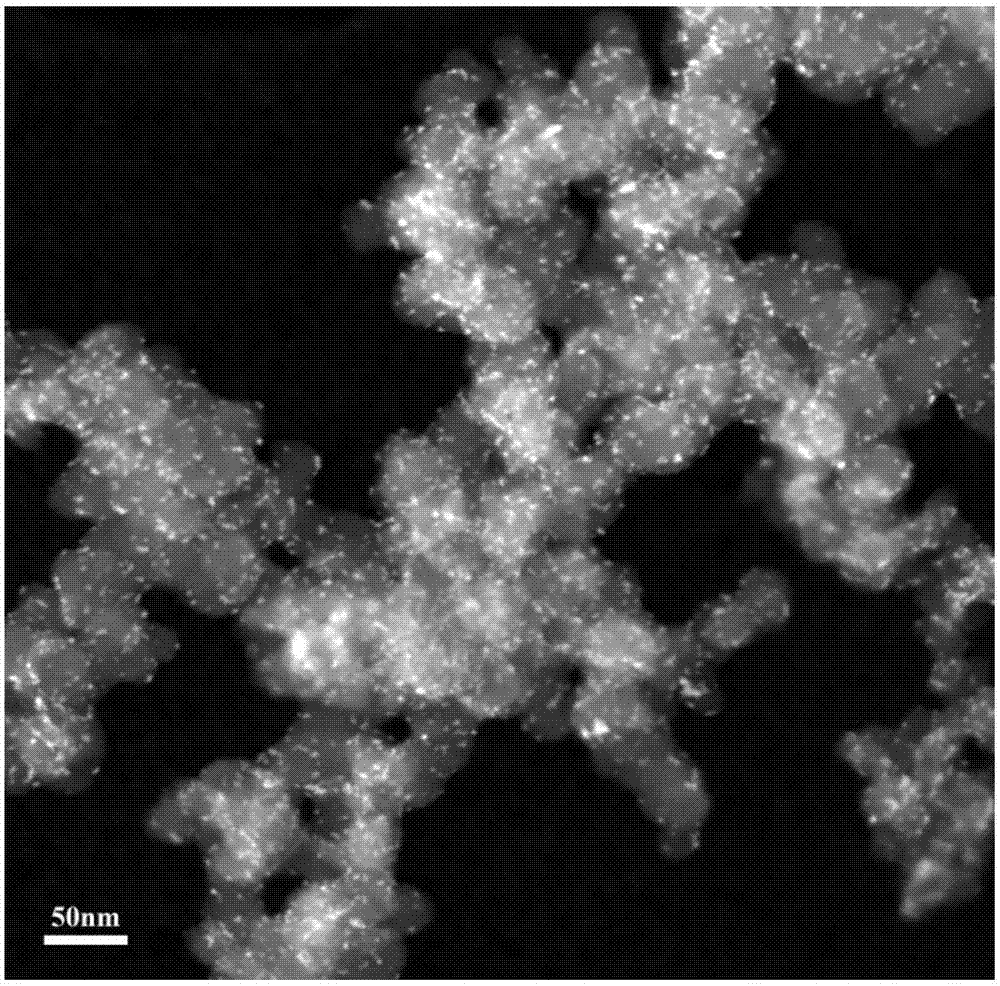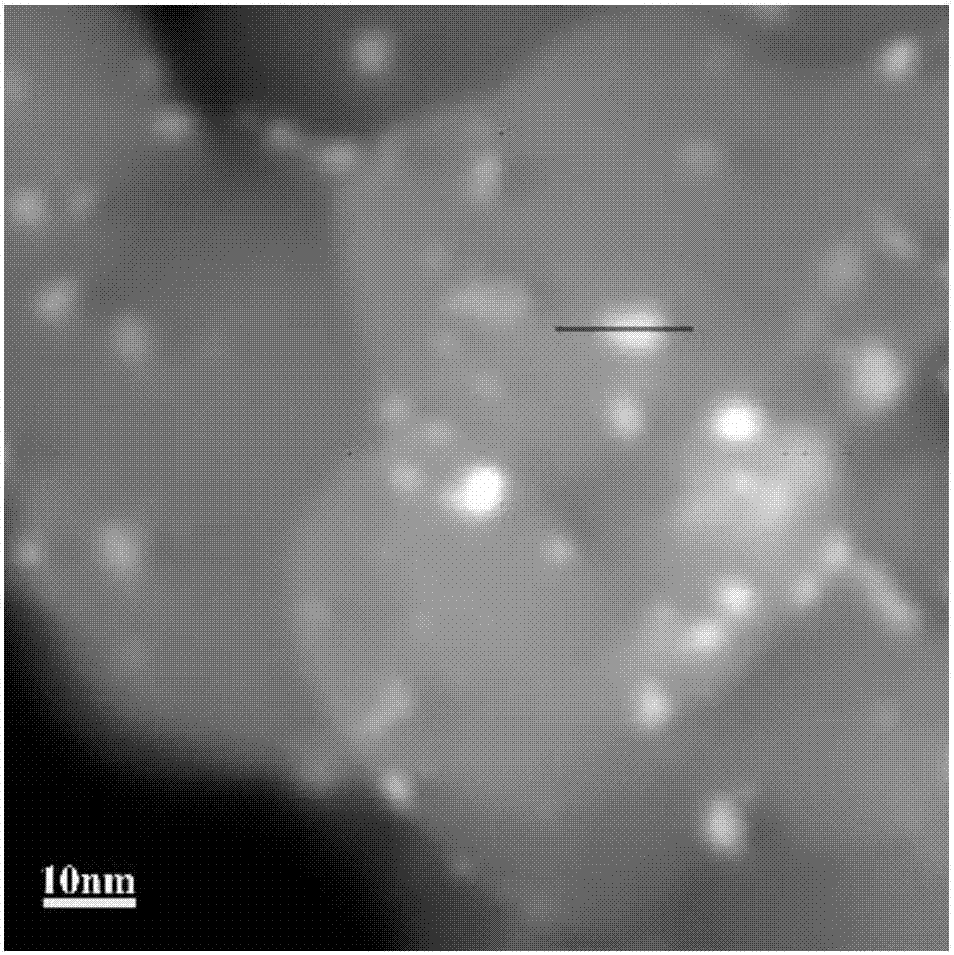Non-alloyed metal complex and its preparation and application
A metal composite, non-alloy technology, applied in the preparation of amino compounds, the preparation of organic compounds, metal/metal oxide/metal hydroxide catalysts, etc., can solve the difficulty of adjusting the catalytic performance, changing the surface structure, and surface structure differences and other problems, to achieve the effect of excellent catalytic performance and strong tunability
- Summary
- Abstract
- Description
- Claims
- Application Information
AI Technical Summary
Problems solved by technology
Method used
Image
Examples
Embodiment 1
[0080] Preparation of platinum copper / activated carbon composite:
[0081] (1) Dissolve 0.32g of anhydrous cupric chloride in 30ml of water, add 50ml of 0.1M NaOH solution to generate a precipitate, stir until the precipitate is complete, centrifuge and wash with water and add the precipitate to 50ml of 28wt% ammonia solution to obtain a copper ammonia solution ; Disperse 3g of activated carbon into 150ml of ethanol, then add dropwise copper ammonia solution, stir until the reaction is complete, heat to 60°C to completely volatilize ammonia and water, and obtain a solid compound; disperse the solid compound in 100ml of water, under nitrogen protection Add 50ml of 0.27M sodium borohydride solution dropwise, centrifuge and wash with water after the reaction is complete, and vacuum freeze-dry to obtain a copper / activated carbon catalyst;
[0082] (2) Dissolve 1 g of chloroplatinic acid (Pt ≥ 37.0%) in 50 ml of ethylene glycol, mix it with 50 ml of 0.25 M NaOH in ethylene glycol u...
Embodiment 2
[0089] Preparation of platinum-nickel / carbon nanotube composites:
[0090] (1) Get 0.31g Anhydrous Nickel Chloride and be dissolved in 30ml water, the NaOH solution of the 50ml 0.1M that adds, generate precipitation, stir until precipitation is complete, after centrifugal washing, precipitation is added in the aqueous ammonia solution of 100ml 30wt%, obtains nickel ammonia solution; disperse 3g of carbon nanotubes into 150ml of ethanol, then dropwise add nickel ammonia solution, stir until complete reaction, heat to 80°C to completely volatilize ammonia and water to obtain a solid compound; disperse the solid compound in 100ml of water, Under the protection of argon, 50ml of 0.27M sodium borohydride solution was added dropwise, after the reaction was complete, it was centrifuged and washed with water, and vacuum freeze-dried to obtain a nickel / carbon nanotube catalyst;
[0091] (2) Dissolve 1g of chloroplatinic acid (Pt≥37.0%) in 50ml of ethylene glycol, mix with 50ml of 0.25M...
Embodiment 3
[0097] Preparation of rhodium-cobalt / carbon nanotube composites:
[0098] (1) Dissolve 0.285g of anhydrous cobalt chloride in 30ml of water, add 50ml of 0.1M KOH solution to generate a precipitate, stir until the precipitate is complete, and add the precipitate to 100ml of 25wt% ammonia solution after centrifugal washing to obtain cobalt ammonia solution ; Disperse 3g of carbon nanotubes in 150ml of ethanol, then dropwise add cobalt ammonium solution, stir until complete reaction, heat to 80°C to completely volatilize ammonia and water, and obtain a solid compound; disperse the solid compound in 100ml of water, argon Add dropwise 50ml of 0.27M hydrazine hydrate solution under air protection, centrifuge and wash with water after the reaction, and vacuum freeze-dry to obtain the cobalt / carbon nanotube catalyst;
[0099] (2) Dissolve 1g of ammonium chloride rhodium acid (Rh ≥ 27.5%) in 50ml of ethylene glycol, mix with 50ml of 0.25M NaOH in ethylene glycol solution under stirring...
PUM
 Login to View More
Login to View More Abstract
Description
Claims
Application Information
 Login to View More
Login to View More - R&D
- Intellectual Property
- Life Sciences
- Materials
- Tech Scout
- Unparalleled Data Quality
- Higher Quality Content
- 60% Fewer Hallucinations
Browse by: Latest US Patents, China's latest patents, Technical Efficacy Thesaurus, Application Domain, Technology Topic, Popular Technical Reports.
© 2025 PatSnap. All rights reserved.Legal|Privacy policy|Modern Slavery Act Transparency Statement|Sitemap|About US| Contact US: help@patsnap.com



